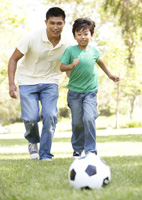|
 Common spring sports injuries and how to avoid them
Common spring sports injuries and how to avoid them
By: Keith Anderson, MD
Sports injury getting you down?
Connect with one of our experts:
704-316-SPRT (7778) |
As the weather warms up, the grass starts to grow and the sun stays out longer each day, many of us become more active. Some people transition from indoor exercise to outdoor exercise, while others resume activities after taking most of the winter as a form of exercise/sports holiday. Whatever the cause, the spring season is a time of year during which injuries can become more prevalent as activities increase.
There are two particular categories of injuries that we often see this time of year: “overuse injuries” and leg ligament injuries.
 “Overuse injuries” occur when athletes submit their bodies and joints to more stress than they are ready to handle. These injuries often manifest as a form of tendonitis but can be seen in other ways. Frequently, they happen because a runner or cyclist puts in too many miles. The weather is warmer, and the temptation to stay outside longer and go farther is strong. But their tendons and muscles just are not conditioned for the accumulative force, so injuries can develop. The best way to prevent this is to ease back into the mileage. Don’t go out on day one or even week one and try to do the mileage that you did in the fall. Do lower-mileage workouts at first, and gradually add distance and time over several weeks as your body adapts to the added stress. “Overuse injuries” occur when athletes submit their bodies and joints to more stress than they are ready to handle. These injuries often manifest as a form of tendonitis but can be seen in other ways. Frequently, they happen because a runner or cyclist puts in too many miles. The weather is warmer, and the temptation to stay outside longer and go farther is strong. But their tendons and muscles just are not conditioned for the accumulative force, so injuries can develop. The best way to prevent this is to ease back into the mileage. Don’t go out on day one or even week one and try to do the mileage that you did in the fall. Do lower-mileage workouts at first, and gradually add distance and time over several weeks as your body adapts to the added stress.
We also see more leg ligament injuries because of the types of sports that are popular in the spring. Sports like soccer, flag football, softball and ultimate Frisbee are often played on grass or turf and involve quicker cutting and side to side movements. Many athletes keep their fitness during the winter months, sweating it out on a treadmill or in a spin class, but do not use the same muscles or do the same quick movements that are needed for these sports. So, it is not surprising that when they suddenly return to the field, we see an increase in ankle sprains and knee injuries. In order to decrease these injuries, athletes should start doing more side to side/cutting training in the weeks leading up to playing these sports to retrain their balance receptors and muscles before trying to go full speed in a game.
Regardless of the cause, many of these injuries can be treated with the same approach.
PPRICE stands for:
- Protection
- Pain control
- Rest
- Ice
- Compression
- Elevation
This treatment can be used for many minor injuries, but for injuries in which the athlete cannot walk or bear weight on the injured side or cannot use the affected muscle or joint, it is best to see a physician to be evaluated for more severe injury.
Dr. Keith Anderson is a board-certified sports medicine and family medicine physician at Novant Health Cotswold Medical Clinic in Charlotte. To schedule a sports medicine consultation with Dr. Anderson or another Novant Health sports medicine physician near you, call 704-316-SPRT (7778) or visit NovantHealth.org/sportsmed. |

